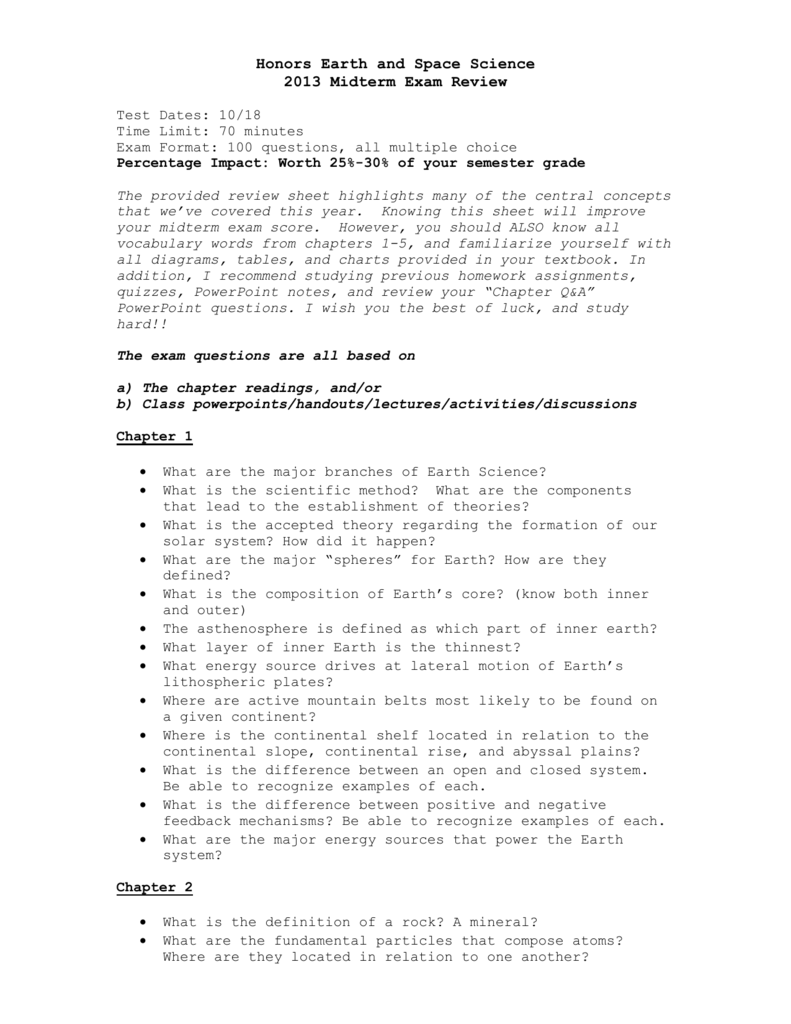Earth Systems Review Final Exam Guide
Study Fossil Ridge High School Earth System Science flashcards and notes. Atmosphere final exam review. All Study Materials from Earth System Science. Earth Systems Final Exam Review - Free download as Word Doc (.doc /.docx), PDF File (.pdf), Text File (.txt) or read online for free. Scribd is the world's largest social reading and publishing site.
Study Guide for First Midterm Exam, Geol 1425 Study Guide for First Midterm Exam, G105 The Big Bang. What evidence do we have in support of this theory? What is the thermal cosmic background radiation? Which astronomer discovered the spectral redshift of galaxies? What conclusion did he draw from that discovery? What do cosmologists mean with the term 'anthrophic principle'?
Final Exam Review
In class we introduced the nebula theory of star and solar system formation. What features of the solar system does this theory predict correctly? How old is the solar system? All the natural elements are a product of nuclear fusion in stars and through supernova explosions. Review the sequence of fusion steps. How far the nuclear fusion cascade goes in a given case depends on the size of the star.

In the case of our sun, what is the likely final stage of nuclear fusion? What would it be in the case of a star that is 20 times larger? How do astronomers determine the chemical composition of stars and galaxies? What must we conclude from the fact that heavy elements, such as uranium, lead, and gold, are found on Earth? What are the major chemical components of -the universe? -the solar system?
-the earth and its component spheres? -the atmosphere?
Review the properties of the sun. What is its role as an energy source for atmosphere and ocean circulation?
How many planets in the solar system? What are their names? How are they arranged relative to the sun? What are asteroids?
What are they made of? How large are they? What do they represent? Review the layered structure of the Earth. Name the layers and their composition. How did we manage to figure out this structure?
Why is iron the most likely candidate to form the Earth's core? How was the early Earth heated up to allow differentiation? What were the different processes that provided heat? What was the process that contributed most of the heat? What processes were active in the accretion and early differentiation of the Earth? What are the processes that transport heat from the Earth's interior to its surface?
Review plate tectonics. What are the basic facts? Who proposed a precursor theory to plate tectonics, the so called theory of 'continental drift'?
The upper mantle of the Earth contains a layer that is mechanically weak (probably due to partial melts) and reacts plastic to deforming forces. What is its name? Does sea floor spreading increase the size of the Earth? Where did most of the water come from that fills the oceans of today's Earth? What gases do we find in the atmosphere? Rank them in order of abundance. How are sedimentary rocks classified?
What are the subdivisions for clastic sedimentary rocks? How are these subdivisions defined? Do any sedimentary rocks precipitate directly from sea water? How are minerals defined? Review our classification scheme for minerals. What are the 'rock forming' minerals? Where do they go in our classification scheme?
What is the composition of the Earth's crust? What are the most abundant chemical elements in the crust? The basic facts about rock forming minerals (micas, orthoclase, etc.) What is the basic building block of all the rock forming minerals? What is it made of?
What is its structure? Igneous rock textures: Know the textures of extrusive and intrusive rocks. Which textures typical for extrusive rocks? Which textures typical for intrusive rocks? What do we mean with the term hydrologic system?
What are its subsystems? Which subsystem is most important in terms of modifying the surface of the continents? What are the energy sources that keep the Earth system going? The water on Earth is partitioned into several reservoirs.
What are these, and how do they rank in terms of total amount of water contained? What are the energy inputs into the Earth system?
How large are they in relative terms? Sedimentary rocks have many features that we can observe and describe. Which feature is ubiquitous to sedimentary rocks and is considered their most distinguishing feature? Know your sedimentary structures. Know their names and what they look like.
Why are they important to geologists? What is the significance of sedimentary rocks?

Think of economic importance, their role as a source of information about earth history, their role as a repository of fossils, their distribution across the surface of the continents (how widespread are they?). What is metamorphism? How does it work? What processes are involved to make a metamorphic rock?

What happens when a rock undergoes metamorphism? What changes do we observe? Grove manlift specifications. What features are gradually destroyed during metamorphism? What do we mean by contact metamorphism? What do we mean by regional metamorphism? Where do the two types of metamorphism mainly occur?